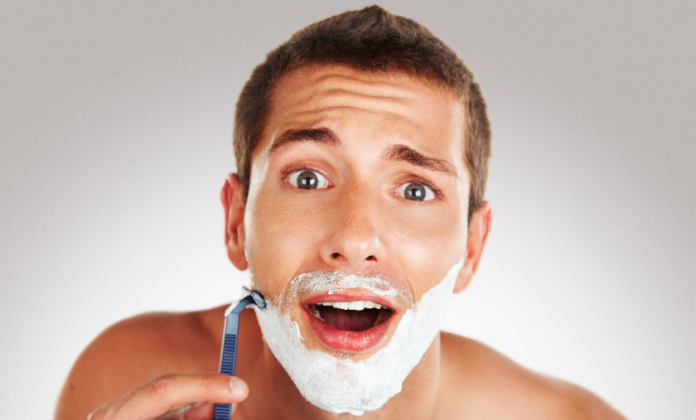
Many men admit they appreciate well-developed breasts, but not when those breasts are staring back at them from the mirror! Man boobs, which are technically known as gynecomastia, is a condition in which there is benign swelling of the breast tissue in men. In most cases, it occurs when there is a hormone imbalance and/or hormones fluctuate naturally, such as during puberty and old age. Man boobs also can be present among men who are overweight or obese. In these cases, the condition is known as pseudogynecomastia, and the breasts result from fat deposits rather than enlargement of breast glands.
Here we are concerned with man boobs associated with hormone imbalance, typically involving rising estrogen (estradiol) levels and/or declining testosterone. More specifically, we will look at men’s use of products that can disrupt hormone balance and thus contribute to the development of man boobs.
The products in question are everyday ones, such as shaving lotion, shampoo, deodorant, body wash, cologne, soaps, plastic water bottles, canned foods, plastic food containers, everyday plastic items, and cashier receipts. All of these items have something in common: the presence of bisphenol-A (BPA), an industrial chemical used in the production of plastics, or phthalates, which are synthetic chemicals used to make plastics softer and more pliable. A common element between these two substances is that both BPA and phthalates can help throw a man’s hormone levels out of balance and give rise to man boobs. That is, they are known as endocrine disruptors or hormone disruptors.
Another hormone disruptor category is parabens, but this one doesn’t have an association with plastics. Parabens are added to personal care products and cosmetics to prevent the growth of microbes in these products. They also have the ability to mimic estrogen and promote breast tissue growth.
BPA
You may be familiar with BPA because of the water bottle hoopla years ago when it was discovered that BPA leached into the water of plastic bottles that contained the chemical and that BPA is an endocrine disruptor. This losing combination resulted in many people switching to BPA-free water bottles made of stainless steel or glass. However, BPA is in more than water bottles.
Register receipts, epoxy resins used to line the inside of food cans, plastic food contains, water supply lines, and bottle tops containing BPA, as well as some dental sealants and composites. Exposure to heat (as in microwaving food in a plastic container-which we never recommend) causes more of the chemical to be released.
A study in Reproductive Toxicology found that abnormal breast growth in both boys and adult men can occur with even minimal exposure to BPA. Bisphenol-A also may be associated with prostate cancer and male infertility.
How to avoid BPA
Every man can take steps to avoid exposure to BPA as much as possible. Here are a few tips:
- Avoid plastic water bottles and plastic food containers, even those that say BPA-free. A substitute for BPA, called BPS, is just as unhealthy as BPA. Trade in your plastic water bottle for a stainless steel or glass container. Store and heat food in ceramic, glass, or pottery containers on the stovetop or in the oven, not in the microwave.
- Avoid canned foods, especially those that contain acidic foods such as tomatoes and tomato products. The acid causes more of the chemical to be removed from the can lining.
- Say “no” to cash register receipts, as many of them contain BPA. If you need a receipt, ask the cashier to email it.
Phthalates
A major issue with phthalates is that you won’t see them listed on the label of your shampoo, lotions, shaving creams, or soaps, nor your laundry detergent or insect repellent. Phthalates are also present in carpeting, car interiors, vinyl flooring, plastic toys (including sex toys), shower curtains, and even meat and dairy foods, so avoiding them can be difficult. In fact, phthalate use is so widespread (about a billion pounds are produced annually), that 95 percent of people have detectable chemical levels in their urine.
Phthalates have been associated with the development of gynecomastia in puberty. One study found that the most commonly used phthalate, di-(2-Ethylhexyl)-phthalate (DEHP), which has both antiandrogenic (male hormone) and estrogenic effects, may be a cause of gynecomastia in adolescent males.
How to avoid phthalates
Avoiding phthalates is nearly impossible, but one significant thing men can do is to use personal care products that are free of these chemicals. Look for organic, all-natural deodorants, shampoos, soaps, lotions, and detergents. If any of these items have a fragrance, be sure it is from a natural source only. If a product has the word “fragrance” or “parfum” on the label, you can almost be guaranteed it contains phthalates. Instead, shop for items that say “scented with essential oils only,” “no synthetic fragrance,” or “phthalate-free.”
Steering clear of phthalates in other items, including meat and dairy products, and choosing natural products (e.g., cloth shower curtains, and wood flooring) are other steps men can take to reduce exposure to these hormone-disrupting chemicals.
Parabens
Unlike phthalates, you will likely see parabens listed on personal care products with names such as butylparaben, ethylparaben, methylparaben, propylparaben, and others. Parabens can block testosterone and inhibit enzymes that metabolize estrogen, throwing a man’s hormones into imbalance. These chemicals are commonly found in shampoo, body lotions, facial cleansers and scrubs, conditioners, toothpaste, and deodorant, among other similar products.
How to avoid parabens
Look for personal care products that say “paraben-free,” or use your own homemade products. The availability of paraben-free items is growing, making it easier to avoid these chemicals.




